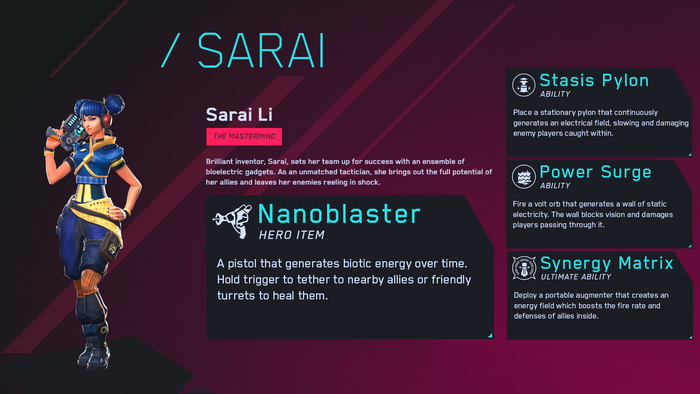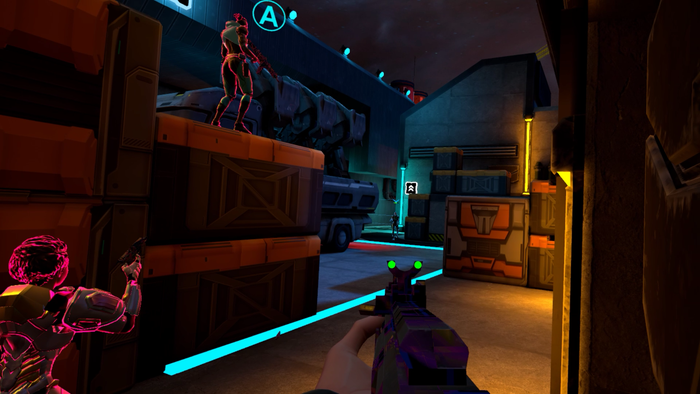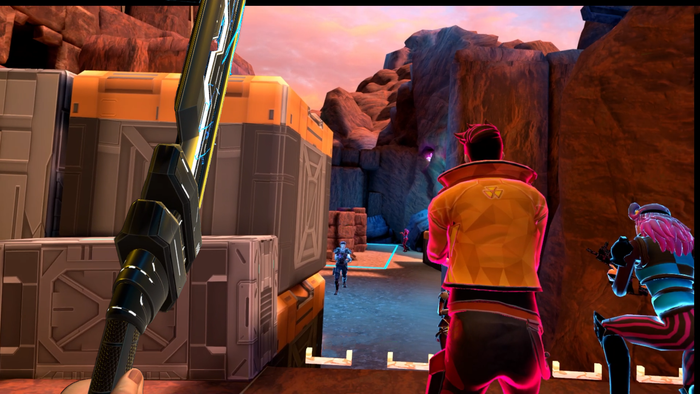Trending
Opinion: How will Project 2025 impact game developers?
The Heritage Foundation's manifesto for the possible next administration could do great harm to many, including large portions of the game development community.

Featured Blog | This community-written post highlights the best of what the game industry has to offer. Read more like it on the Game Developer Blogs or learn how to Submit Your Own Blog Post
This blog discusses the pillars that have defined X8’s path to launch.

Is creating a 5v5 VR Multiplayer Hero Shooter game and fostering an engaged community the same in VR as it is for console or PC? Yes and no. Many elements are the same – making it fun, building a community, designing heroes with special abilities that can be mixed and matched. But a few things are different. This blog discusses the pillars that have defined X8’s path to launch in the Meta Quest Store on November 9:
Pillar 1: Focus on Quality and Community Building From day one, we knew our game lived or died on fostering a thriving community of players. This is how we went about building our community:
Start with a Closed Beta: Our journey to create this community began with two Closed Beta testing phases. These tests allowed us to gather invaluable feedback from our early players, helping us identify and address critical issues, such as onboarding, matchmaking, and user experiences. We continued to update the game based on this feedback, ensuring that the community's voice was heard.
Move to Open Beta Using Platforms’ Early Access: We launched on Meta App Lab and Steam for Early Access in late May to also help build and strengthen our existing community, plus learn from their feedback. During the Open Beta period, we continued to refine our vision and polish gameplay experience.

Innovate – Start VR Esports Industry: One of our most ambitious goals with X8 is to establish VR esports as a mainstream phenomenon. In August, we launched the first official X8 League in partnership with VR esports organization, Virtual Athletics League (VAL). The eight-week season kicked off in late September where players compete in 5v5 demolition matches each week to climb the rankings and aim for a piece of the substantial $10,000 cash prize pool. This high prize pool is a testament to our commitment to promoting VR esports and providing competitive opportunities for our players. It's a step towards bringing the world of VR gaming to the forefront of competitive esports entertainment and recognizing the skill and dedication of our top players.
VR has enormous growth potential as worldwide content, and we're determined to be at the forefront of this movement. We’ve hosted three VR esports events with X8, including an Early Access Invitational Tournament in May, and a tournament at the Tokyo Game Show (TGS) in September. With over 500 participants in our event at TGS, this event marked the first-ever VR esports event in Japan, setting a precedent for the future. We also organized the Japan University tournament, which included ten top-tier universities from across Japan with thriving esports clubs. This event showcased the unique and sensational VR contest that left a lasting impression on the audience.
Pillar 2: Choose the Correct Business Model to Match Gameplay

Why We Made X8 'Free to Play' – We made the deliberate decision to make X8 a 'Free to Play' game, and here's why. We took inspiration from the success of non-VR shooter games like Overwatch, Apex Legends, and VALORANT, which have thrived under the free-to-play model. While the VR market is still evolving and smaller compared to other gaming platforms, it's crucial to follow successful case studies and business models.
Make Accessible to Most Players – In traditional sports like basketball, soccer, or baseball, anyone can play for free with minimal equipment. Similarly, we want X8 to be accessible to as many players as possible, ensuring that everyone has a chance to compete and succeed. With a large player base, the community wins and the individual players win.
Pillar 3: Pay Attention to the Subtle Game Design Differences in VR
From a game development perspective, there are many similarities in developing a 5x5 VR shooter versus a 5x5 console shooter game. However, VR design can be delicate, and even minor design elements can be the difference between making your game fun or barely playable.
Here are a couple of key elements to pay attention to.
Mind the Game Settings: Options (and the amount of options) within game settings can make or break a VR game. As we all know, VR can make some users feel queasy. There is a major difference between playing a game in a world where your viewport is only a 2D flat screen and playing in a world where your brain believes that you are "in that world". In a 2D game setting, there may be limited options and a player will adapt to work around those limitations. Whereas that same player in a VR world cannot adapt.
A critical example of this is the locomotion comfort setting of Snap Turn vs. Smooth Turn. Using a game stick to control where and how your head or body turns can be very dissociative, even for players who have played VR for years. A control scheme that works for one player can be downright nauseating for another. These are individual settings that must be modified by the player. Making a multitude of optional locomotion comfort settings is a must in good VR development. Providing an array of options can make an invaluable difference in creating a positive experience for the player.

Other options outside of locomotion settings can also make a significant difference in VR vs. console play. Let's look at something as basic as pocket layout. Button mapping for what to grab in your player's hand in a console experience is a rather small change compared to what a user can experience in VR. Something as basic as grabbing an ammo magazine in VR starts to get complicated rather quickly. Is the player right or left hand dominant? Do they prefer to grab magazines from their shoulder pocket (games like Half-Life Alex use this motion) or is their reload preference similar to other popular VR FPS shooters from the hip. With VR it may not be a simple button press, instead it's an actual body motion. An unfamiliar gameplay motion that doesn't "feel" right can turn from frustrating to satisfying simply based on quick optional preference setting - but the option HAS to be available. In VR the more options you can give the player, the more likely it is that the player's brain will adapt to the space you provide them, and feel not only immersive but also comfortable and familiar.
Make it Feel Like A VR Experience: X8 is not a room-based VR game, but still very motion-based (if the player chooses it to be). Players won't be able to run throughout the levels in real space, however movements like leaning around corners and crouching into cover are all part of the VR immersion. Conversely, even though it is VR, as a developer we strongly lean into options for accessibility settings. Players that can't (or choose not to) stand can select options that allow them to play seated with movements such as crouching, initiated with the controller.
For a multitude of reasons each hero's core abilities (and their hero item) rely completely on controller input and do not use real-world, motion-based interactions from the player. There are however a number of movements, abilities and interactions that all players can employ, which do take advantage of physical world interactions. Movement such as throwing knives, climbing, tossing items to teammates, planting and defusing the Syphon, all require physical real world movements and interactions.These types of interactions make a VR game more immersive, but there is a limit to what the player can initially learn. Too many specific VR interactions (without ramp up teaching) can make the learning curve near impossible for a new player, and too few physical interactions can make the game feel like nothing more than a console port. VR immersion walks a fine line in crafting this experience.

A critical development pillar of X8 is designing a compelling VR experience, using a variety of gameplay options, an adaptive control schema, and various real world movements. The project has endeavored to evolve a playstyle from the shoulders of the 2D Heroic Shooter genre to create a unique immersive experience, unlike anything players have encountered before.
You May Also Like